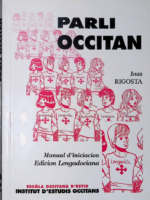| book-author | |
|---|---|
| format |
Die Beziehungen des Felibrige zu den Trobadors
0,00 €
Customer Reviews
There are no reviews yet.
| Category: | Estudis e monografics |
|---|---|
| Tags: | alemanh, estudis, istòria, lectures, novella istorica, occitan, trobadors |
| book-author | |
|---|---|
| format |

Per toti es publicacions
Pes libres en format papèr
En lengua occitana
Tòn equipa ath tòn servici
De A autant d’argent que de pesolhs à Virar coma un baciu fagord, ce sont plus de 1000 expressions et dictons occitans, enracinés au plus profond de notre quotidien, qui sont réunis et expliqués dans cet ouvrage. A leur source, l’observation et l’imagination pour les unes : Aimable coma una mosca d’ase ; Aver d’argent coma un chin de nièras ; Aver un cuol coma un amolaire ; Cargat coma un muol; Curios coma un pet ; Dormir coma una missara. la musicalité et la rime qui facilitent la mémorisation pour les autres : Al mes d’abriu, Io cocut canta, mort o viu ; Auba roja, vent o ploja ; Cada topin troba sa cabucèla ; Es lo matin que la jornada se pèrd o se ganha ; Grèc, pluèja al bec ; La raça raceja. Tous ont été choisis par l’auteur à partir d’enquêtes et de lectures personnelles.
An edition and translation of some 30 poems by the trobairditz, a remarkable group of women poets from the 12th and 13th centuries, who composed in the style and language of the troubadours.
An Introduction to Old Occitan is the only textbook in print for learning the language used by the troubadours in southern France during the Middle Ages. Each of the thirty-two chapters discusses a subject in the study of the language (e.g., stressed vowels, subjunctive mood) and includes an exercise based on a reading of an Occitan text that has been edited afresh for this volume. An essential glossary analyzes every occurrence of every word in the readings and gives cognates in other Romance languages as well as the source of each word in Latin or other languages. The book also contains a list of prefixes, infixes, and suffixes and a dictionary of proper names. An accompanying compact disc includes discussion of the pronunciation of the language, with illustrations from the texts in the book, and musical performances by Elizabeth Aubrey, of the University of Iowa.
Joseph Anglade siguec professor ena Universitat de Tolosa.
L’idée du présent travail date de plus de vingt-cinq ans..
Er Estatut d’Autonomia hè oficiau era lengua occitana en Catalonha. Se concrète en Art 6.5.: Era lengua occitana, nomentada aranés en Aran, ei era lengua pròpria d’aguest territòri e ei oficiau en Catalonha, cossent damb çò qu’establissen aguest Estatut e es leis de normalizacion lingüistica. Ua des responsabilitat qu’a d’assumir era institucion, ei a dí- der era Generalitat e eth Conselh Generau d’Aran, en procès de metuda era practica dera oficialitat dera lengua occitana, ei era sua referéncia lingüistica. Ua lengua a de besonh uns referents clars entà mostrar ua coeréncia normatiua.
S’era lengua ei ua, era occitana, ua a d’èster era nòrma de referéncia maugrat que pòden èster diuèrses es interpretacions e aplicacions.
Era aplicacion der Estatut hè de besonh era contínua relacion damb aguesta nòrma referent e damb era sua forma l’aplicacion. En cas der aranés aguesta nòrma occitana se concrète enes Nòrmes ortografiques der aranés que ja an mès de vint-e-cinc ans d’emplec sociau (escòla, administracion, …).
Es elements fonamentaus d’aguesta nòrma referent son longaments acceptats en tot eth territòri lingüistic, mès mos cau concretar e èster eth maxim de rigorosi, donques qu’era sua gestion non ei tostemp clara e evidenta. Sense aguest rigor es decisions non serien competentes e serioses. Ei plan per açò que, per manca d’ua autoritat normatiua de tot eth territòri lingüistic, era Secretaria de Politica Lingüistica s’a dotat der assessorament d’un Grop de Lingüistica Occitana (GLO) format per setze persones prestigioses en estudi dera lengua occitana, qu’amasse fòrça des sen- sibilitats existentes. Entre es compausants deth Grop i a tres membres der Institut d’Estudis Aranesi que garantissen eth respècte per aguesta varietat.
Mès, eth GLO non ei era autoritat, non cree nòrma, sonque l’ administre e assessore ara SPL ena sua aplicacion. Trabalhe ena perspectiva dera unitat lingüistica, e eth respècte dera varietat aranesa, sense hèr nòrma.
Ath torn der ahèr aranés-occitan s’a produsit un debat, en fòrça escadences rei- teratiu, sus er ensemblatge dera varietat aranesa e dera sua nòrma damb era varietat generau (hugim de denominacions coma estandard o referenciaus entà non entrar en competéncies pròpries dera autoritat lingüistica). Aguesta varietat generau a estat denominada d’ues autes formes per diuèrsi autors: occitan larg, occitan comun, neolanguedocian, occitan ortopedic, occitan referenciau,…
Eth trabalh que ven a contunhacion ei ua contribucion ad aguest debat. Es sòns autors son professionaus dera lengua, boni coneishedors dera varietat aranesa e dera varietat generau dera lengua occitana. Damb eri eth debat non s’acabe, ne s’inície, sonque se contunhe.
This is the first twentieth-century study of the women troubadours who flourished in Southern France between 1150 and 1250 — the great period of troubadour poetry. The book is comprised of a full-length essay on women in the Middle Ages, twenty-three poems by the women troubadours themselves in the original Provencal with translations on facing pages, a capsule biography of each poet, notes, and reading list.

Be the first to review “Die Beziehungen des Felibrige zu den Trobadors”
You must be logged in to post a review.